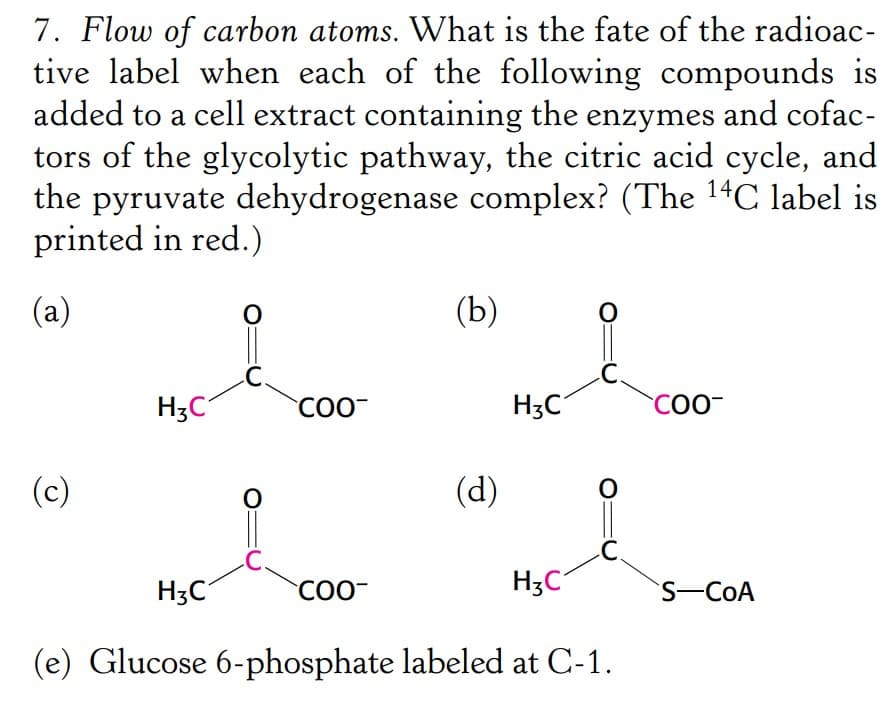7. Flow of carbon atoms. What is the fate of the radioac- tive label when each of the following compounds is added to a cell extract containing the enzymes and cofac- tors of the glycolytic pathway, the citric acid cycle, and the pyruvate dehydrogenase complex? (The 14C label is printed in red.) (a) (c) H₂C H3C O C. O COO™ COO (b) (d) H3C H₂C O C. O C. (e) Glucose 6-phosphate labeled at C-1. COO™ S-COA
7. Flow of carbon atoms. What is the fate of the radioac- tive label when each of the following compounds is added to a cell extract containing the enzymes and cofac- tors of the glycolytic pathway, the citric acid cycle, and the pyruvate dehydrogenase complex? (The 14C label is printed in red.) (a) (c) H₂C H3C O C. O COO™ COO (b) (d) H3C H₂C O C. O C. (e) Glucose 6-phosphate labeled at C-1. COO™ S-COA
Biology (MindTap Course List)
11th Edition
ISBN:9781337392938
Author:Eldra Solomon, Charles Martin, Diana W. Martin, Linda R. Berg
Publisher:Eldra Solomon, Charles Martin, Diana W. Martin, Linda R. Berg
Chapter8: How Cells Make Atp: Energy-releasing Pathways
Section: Chapter Questions
Problem 4TYU: In the first step of the citric acid cycle, an acetyl group from acetyl CoA reacts with oxaloacetate...
Related questions
Question

Transcribed Image Text:7. Flow of carbon atoms. What is the fate of the radioac-
tive label when each of the following compounds is
added to a cell extract containing the enzymes and cofac-
tors of the glycolytic pathway, the citric acid cycle, and
the pyruvate dehydrogenase complex? (The ¹4C label is
printed in red.)
(a)
(c)
H3C
H3C
O
C.
O
C.
COO
COO-
(b)
(d)
H3C
H₂C
O
C.
O
C.
(e) Glucose 6-phosphate labeled at C-1.
COO™
S-COA
Expert Solution
Step 1
Since you have posted multiple questions with multiple sub parts, we will provide the solution only to the first three sub parts of the first question as per Q&A guidelines. Please repost the remaining question by specifying the sub parts need to be answered.
Six-carbon glucose enters the glycolytic pathway where it is converted into two molecules of 3 carbon pyruvate in a series of enzymatic reactions. Pyruvate is then converted to acetyl CoA by pyruvate dehydrogenase complex. Acetyl CoA enters the TCA cycle by reacting with oxaloacetate.
Trending now
This is a popular solution!
Step by step
Solved in 4 steps with 18 images

Follow-up Questions
Read through expert solutions to related follow-up questions below.
Follow-up Question
In follow up would it be possible to do part D and E in the question as well?
Solution
Recommended textbooks for you

Biology (MindTap Course List)
Biology
ISBN:
9781337392938
Author:
Eldra Solomon, Charles Martin, Diana W. Martin, Linda R. Berg
Publisher:
Cengage Learning

Biochemistry
Biochemistry
ISBN:
9781305577206
Author:
Reginald H. Garrett, Charles M. Grisham
Publisher:
Cengage Learning

Anatomy & Physiology
Biology
ISBN:
9781938168130
Author:
Kelly A. Young, James A. Wise, Peter DeSaix, Dean H. Kruse, Brandon Poe, Eddie Johnson, Jody E. Johnson, Oksana Korol, J. Gordon Betts, Mark Womble
Publisher:
OpenStax College

Biology (MindTap Course List)
Biology
ISBN:
9781337392938
Author:
Eldra Solomon, Charles Martin, Diana W. Martin, Linda R. Berg
Publisher:
Cengage Learning

Biochemistry
Biochemistry
ISBN:
9781305577206
Author:
Reginald H. Garrett, Charles M. Grisham
Publisher:
Cengage Learning

Anatomy & Physiology
Biology
ISBN:
9781938168130
Author:
Kelly A. Young, James A. Wise, Peter DeSaix, Dean H. Kruse, Brandon Poe, Eddie Johnson, Jody E. Johnson, Oksana Korol, J. Gordon Betts, Mark Womble
Publisher:
OpenStax College

Biology: The Dynamic Science (MindTap Course List)
Biology
ISBN:
9781305389892
Author:
Peter J. Russell, Paul E. Hertz, Beverly McMillan
Publisher:
Cengage Learning